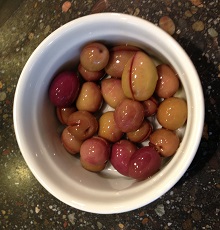
First batch of brine cured olives from abandoned Folsom olive orchard.
I had no idea that I was on the fore front of the Mediterranean healthy food diet when I decided to cure some olives from an abandoned orchard near my house. Just as I deemed my first batch of olives cured and ready to eat, The New England Journal of Medicine released a study, Primary Prevention of Cardiovascular Disease with a Mediterranean Diet. The article states in the opening paragraph,
The traditional Mediterranean diet is characterized by a high intake of olive oil, fruit, nuts, vegetables, and cereals; a moderate intake of fish and poultry; a low intake of dairy products, red meat, processed meats, and sweets; and wine in moderation, consumed with meals.
A systematic review ranked the Mediterranean diet as the most likely dietary model to provide protection against coronary heart disease.
Pioneer Trail of olives
The Pioneer Express Trail as you come into the olive orchard.
My path to the Mediterranean diet literally started as a trail run down the Pioneer Express Trail in Folsom, CA. It was autumn and I was running through the dusty trail surrounded by golden dry grass and live oaks when, from around a bend, an olive orchard opened up in front of me. The olive trees were huge, all lined up in neat rows up the hill. The orchard had been abandoned when the California Park system acquired it when they were building Folsom Dam.
Fruit of the garden, yuk!
Tree ripened olives from the abandoned olive orchard along the Pioneer Express Trail.
As I entered this unexpected garden of olive trees, I decided to commune with nature, plucked a ripe olive off a tree and took a bite. Whoa! It was the bitterest piece of fruit I had ever tasted. The acidic taste would stay in my mouth until I got home and rinsed with copious amounts of water. How could something so farm fresh idyllic looking taste so bad I thought?
Pioneers in Folsom knew how to cure
Long story short: I found out you have to “cure” the olives to remove the excess bitter tasting oleuropien
Washed and ready to pack in the brine solution.
compound. I figured if they could cure olives 3,000 years ago I could certainly do it today with all the modern technology at my disposal. Modern or not, my chosen method to cure with a brine solution would still take months.
Not gourmet, but edible
After a four month brine cure, I rinsed one batch and repacked them with a lower salt solution, red wine vinegar and olive oil. We tasted them last week and, while not perfect, they were edible. There was still a hint of the bitterness and some of the olives had become a little mushy, but they weren’t bad. When I consider that I just grabbed a bunch of olives from the abandon orchard of different sizes and levels of ripeness, pale green to dark red, my first attempt to cure olives seems like a success.
The real benefits of the olive
My foray into harvesting free-range olives and figuring out how to make them edible is obviously part of a smart diet. The NEJM article determined the old world diet has some real benefits for the heart.
In this trial, an energy-unrestricted Mediterranean diet supplemented with either extra-virgin olive oil or nuts resulted in an absolute risk reduction of approximately 3 major cardiovascular events per 1000 person-years, for a relative risk reduction of approximately 30%, among high-risk persons who were initially free of cardiovascular disease. These results support the benefits of the Mediterranean diet for cardiovascular risk reduction. They are particularly relevant given the challenges of achieving and maintaining weight loss.
One element that was interesting is that it is not entirely understood on how the constituents of the Mediterranean diet work to achieve better cardiovascular health.
Our results compare favorably with those of the Women’s Health Initiative Dietary Modification Trial, wherein a low-fat dietary approach resulted in no cardiovascular benefit. Salient components of the Mediterranean diet reportedly associated with better survival include moderate consumption of ethanol (mostly from wine), low consumption of meat and meat products, and high consumption of vegetables, fruits, nuts, legumes, fish, and olive oil. Perhaps there is a synergy among the nutrient-rich foods included in the Mediterranean diet that fosters favorable changes in intermediate pathways of cardiometabolic risk, such as blood lipids, insulin sensitivity, resistance to oxidation, inflammation, and vasoreactivity.
Like grandma made
Two small batches of olives curing.
One of the reasons people chose to participate in the study was an acknowledgement that “They wanted to eat the way their grandfathers ate,” Dr. Ramón Estruch of the University of Barcelona, the lead author of the study said. Of course, our grandparent’s diet consisted of far fewer processed foods and more home made foods.
Garden diet
I am all for people eating healthy, but I think there is something to making your own food as well. The more foods stuffs we gather from the garden or cure to make palatable, the fewer additives and sugars we consume. That has to be important on some level as well. The process of curing olives is a little like watching paint dry on a wall. But it is easy and fun when you get to taste the fruit of your labor. This fall I will be back out harvesting more free range abandoned orchard olives for another batch of what I hope will be an even better crop of cured olives.